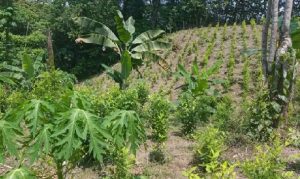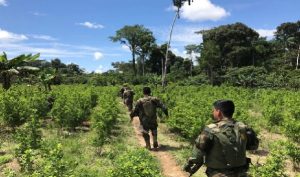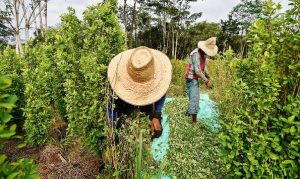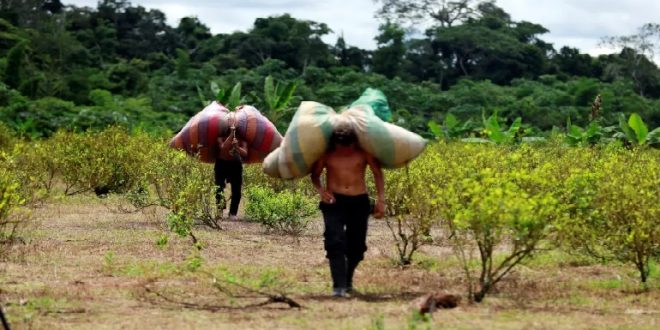03-04-2023
BOGOTA: Farmers in parts of Colombia say sales of coca, the raw ingredient used to make cocaine, have collapsed after a recent surge in production of the illicit drug.
“We’ve seen a complete collapse of buyers,” said Andres Rojas, a coca farmer in the Catatumbo region who advocates for sustainable farming practices among growers. “Entire crops are going unsold, and families are going hungry.”
 Representatives from farming associations in Catatumbo, Nariño, Cauca and Putumayo, the biggest coca-producing regions in the country, have called the economic fallout of the collapse a “humanitarian emergency”.
Representatives from farming associations in Catatumbo, Nariño, Cauca and Putumayo, the biggest coca-producing regions in the country, have called the economic fallout of the collapse a “humanitarian emergency”.
Rojas explained that, in recent years, many farmers in Catatumbo abandoned food crops in favor of growing coca, in part because transporting harvests from remote regions to sell in urban centres is cost prohibitive and difficult, given the lack of rural infrastructure.
As a result, many communities are now dependent on the illicit coca economy.
“Rising coca prices in recent years meant many farmers chose to plant coca exclusively,” he said. “This lack of agricultural and economic diversity means the community is even more hard hit [by the drop in prices]. Many people don’t even grow food crops anymore.”
“The absence of coca paste buyers is leading to hunger in coca-growing territories,” President Gustavo Petro acknowledged in a Twitter post on March 22.
He called for the reinstatement of government-led coca-substitution programs, which would pay farmers coca-growing regions to cultivate alternative crops.
 Those programs were an integral part of Colombia’s 2016 peace accord with the Revolutionary Armed Forces of Colombia (FARC), the country’s largest rebel group at the time but when President Ivan Duque came to power in 2018, the government shifted to more aggressive “war on drugs” tactics, rather than pursuing social solutions to coca production.
Those programs were an integral part of Colombia’s 2016 peace accord with the Revolutionary Armed Forces of Colombia (FARC), the country’s largest rebel group at the time but when President Ivan Duque came to power in 2018, the government shifted to more aggressive “war on drugs” tactics, rather than pursuing social solutions to coca production.
The coca-substitution programs were largely stonewalled and even dismantled.
Colombia is the largest producer of cocaine in the world, and 2021 was a record year for production. The United Nations Office on Drugs and Crime (UNODC) estimated that 204,000 hectares (504,095 acres) were dedicated to coca cultivation in 2021, and production has been trending upwards since 2012 but coca prices began to drop in early 2022, according to Daniel Parra, the border coordinator for the Peace and Reconciliation Foundation (PARES).
“By the end of the year,” he explained, “prices had bottomed out, and buyers for coca paste had become scarce.”
Parra suspects a combination of factors are to blame for the collapse. One may be the fallout from the 2022 arrest and extradition of the drug lord Dairo Antonio Usuga David, who used the moniker “Otoniel”.
 Now in the United States, Otoniel pleaded guilty in January to running a criminal enterprise in his role as a leader of the Gaitanista Self-Defence Forces of Colombia (AGC), also known as the Gulf Clan. He also admitted to smuggling “tons of cocaine, perhaps hundreds of tons” into the US.
Now in the United States, Otoniel pleaded guilty in January to running a criminal enterprise in his role as a leader of the Gaitanista Self-Defence Forces of Colombia (AGC), also known as the Gulf Clan. He also admitted to smuggling “tons of cocaine, perhaps hundreds of tons” into the US.
As Otoniel awaits his prison sentence, Parra said the AGC has started to reorganize, shifting its attention away from the international cocaine trade, resulting in lower demand.
“We think AGC may have begun to focus on other illicit income streams, such as illegal mining, extortion and domestic sales of illicit substances rather than multinational smuggling,” Parra said.
Moving its business away from large-scale cocaine production could help the AGC as it engages in peace talks with Petro’s administration but it could also be a form of retribution, he added. (Int’l News Desk)
 Pressmediaofindia
Pressmediaofindia




